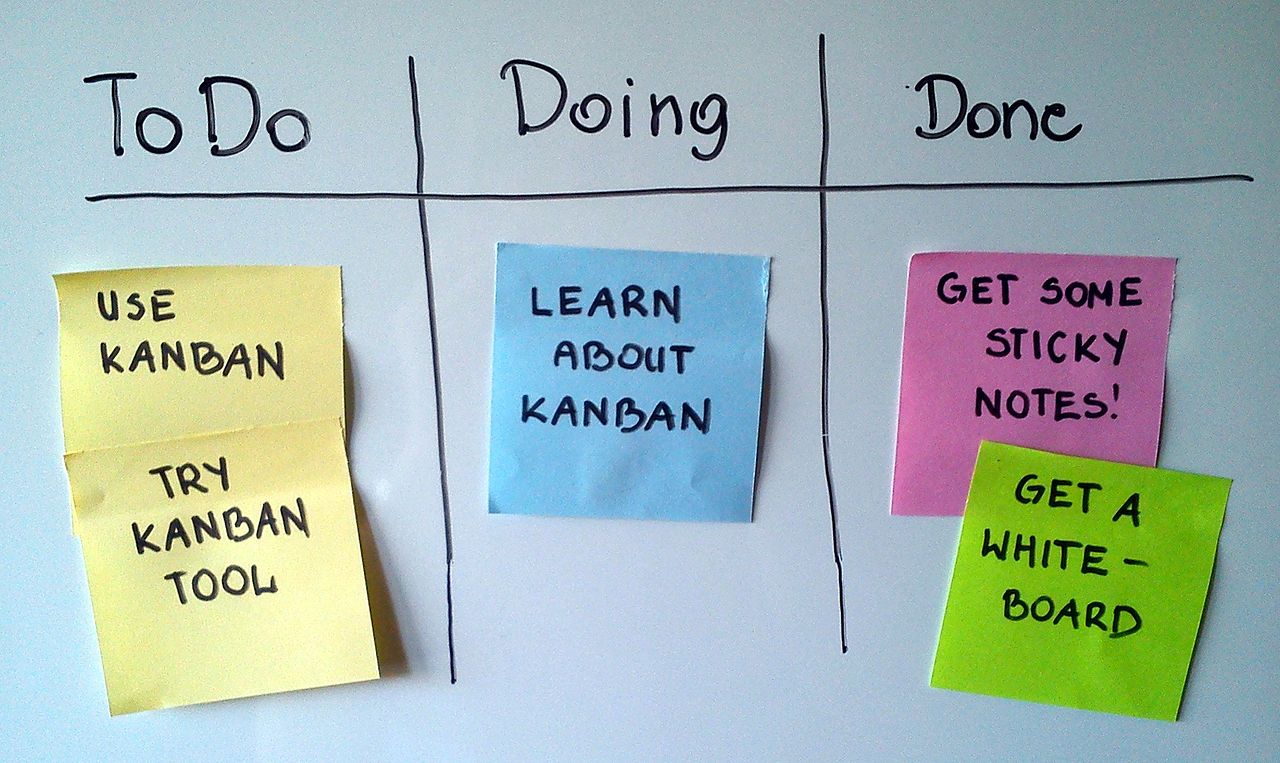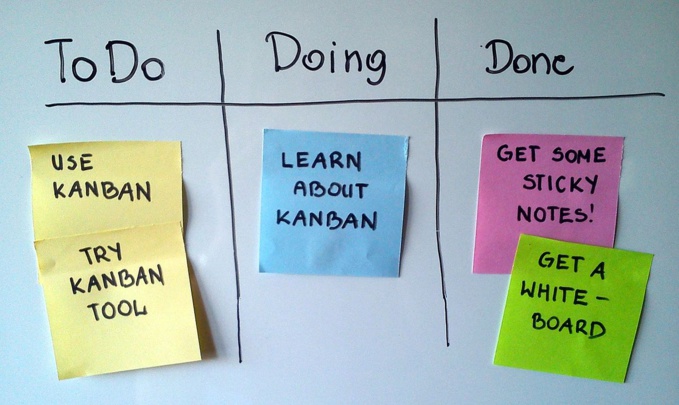If the work becomes visible, the professional level of the team will increase, because it contributes to the work of the brain, but does not interfere with it.
Visualizing work is one of the most important tasks that will improve the workflow, because the human brain is designed to look for meaningful patterns and structures in what the visual organs perceive.
Visual systems such as kanban boards can be used to make the work visible. It is a surprisingly simple way to identify work requirements, that is, the volume and type of tasks that everyone, including ourselves, requires us to do, and begin to fight with the problem of time wasting. As soon as the work becomes visible, we will have tools for solving problems that slow down the workflow.
Kanban boards start with the simplest basis - three columns under the names “List of tasks”, “In progress”, “Done”. The genius of this board is that it speaks for itself - either you need to start the task, or it is already at work, or you completed it. Everyone can create such a simple system. And apply it easily to any task.
It also allows you to streamline the amount of work that would otherwise be uncontrollable or completely invisible. Imagine that such a board is hanging in your office: it is so simple and informative that you don’t have to explain anything to anyone - anyone who enters the office can look at it and understand what you are working on and what stage you are at, without distracting you with questions.
Most boards consist of at least three columns that display the current status of the process. The work is presented in the form of cards. But how to use a kanban board efficiently?
First of all, you need to consider several points. For example, if your list of tasks is too long, consider whether it is really necessary to put all of them on the board. The question is: what to weed out? Some things are so insignificant that it makes no sense to litter the task column with them, otherwise they will distract you from more important matters. In addition, by the time you complete three to five key priorities, the next group of priorities will probably change.
What tasks can you ditch? What gives visibility to your team and others? Answer: circumstances influence this. What to visualize depends on the type of work and the main problems.
The choice of tasks that fall on the board is determined by the ratio of the time required to work and the total value. 15 minutes-task can often be left. However, there are exceptions. If the task is solved in just 10 minutes, this does not mean that it is unimportant.
It is advisable to track 10-minute tasks if:
1. Only one person knows how to complete a task. If you visualize the work, it stimulates the necessary mutual learning.
2. Work affects other teams. Cross-command dependencies in the work can take quite large sizes. You will spend only a couple of minutes creating a card for a kanban board, but build competent interaction between groups.
3. One of the employees is entrusted with tasks, the implementation of which requires a maximum of 15 minutes, that is, if the work of this person is not monitored, it is invisible. If large volumes of work remain invisible, then it is very easy to load this person with a huge number of additional tasks, in addition to the standard volume of his duties.
based on "Making Work Visible. Exposing Time Theft to Optimize Work & Flow" by Dominica Degrandis
Visualizing work is one of the most important tasks that will improve the workflow, because the human brain is designed to look for meaningful patterns and structures in what the visual organs perceive.
Visual systems such as kanban boards can be used to make the work visible. It is a surprisingly simple way to identify work requirements, that is, the volume and type of tasks that everyone, including ourselves, requires us to do, and begin to fight with the problem of time wasting. As soon as the work becomes visible, we will have tools for solving problems that slow down the workflow.
Kanban boards start with the simplest basis - three columns under the names “List of tasks”, “In progress”, “Done”. The genius of this board is that it speaks for itself - either you need to start the task, or it is already at work, or you completed it. Everyone can create such a simple system. And apply it easily to any task.
It also allows you to streamline the amount of work that would otherwise be uncontrollable or completely invisible. Imagine that such a board is hanging in your office: it is so simple and informative that you don’t have to explain anything to anyone - anyone who enters the office can look at it and understand what you are working on and what stage you are at, without distracting you with questions.
Most boards consist of at least three columns that display the current status of the process. The work is presented in the form of cards. But how to use a kanban board efficiently?
First of all, you need to consider several points. For example, if your list of tasks is too long, consider whether it is really necessary to put all of them on the board. The question is: what to weed out? Some things are so insignificant that it makes no sense to litter the task column with them, otherwise they will distract you from more important matters. In addition, by the time you complete three to five key priorities, the next group of priorities will probably change.
What tasks can you ditch? What gives visibility to your team and others? Answer: circumstances influence this. What to visualize depends on the type of work and the main problems.
The choice of tasks that fall on the board is determined by the ratio of the time required to work and the total value. 15 minutes-task can often be left. However, there are exceptions. If the task is solved in just 10 minutes, this does not mean that it is unimportant.
It is advisable to track 10-minute tasks if:
1. Only one person knows how to complete a task. If you visualize the work, it stimulates the necessary mutual learning.
2. Work affects other teams. Cross-command dependencies in the work can take quite large sizes. You will spend only a couple of minutes creating a card for a kanban board, but build competent interaction between groups.
3. One of the employees is entrusted with tasks, the implementation of which requires a maximum of 15 minutes, that is, if the work of this person is not monitored, it is invisible. If large volumes of work remain invisible, then it is very easy to load this person with a huge number of additional tasks, in addition to the standard volume of his duties.
based on "Making Work Visible. Exposing Time Theft to Optimize Work & Flow" by Dominica Degrandis



















